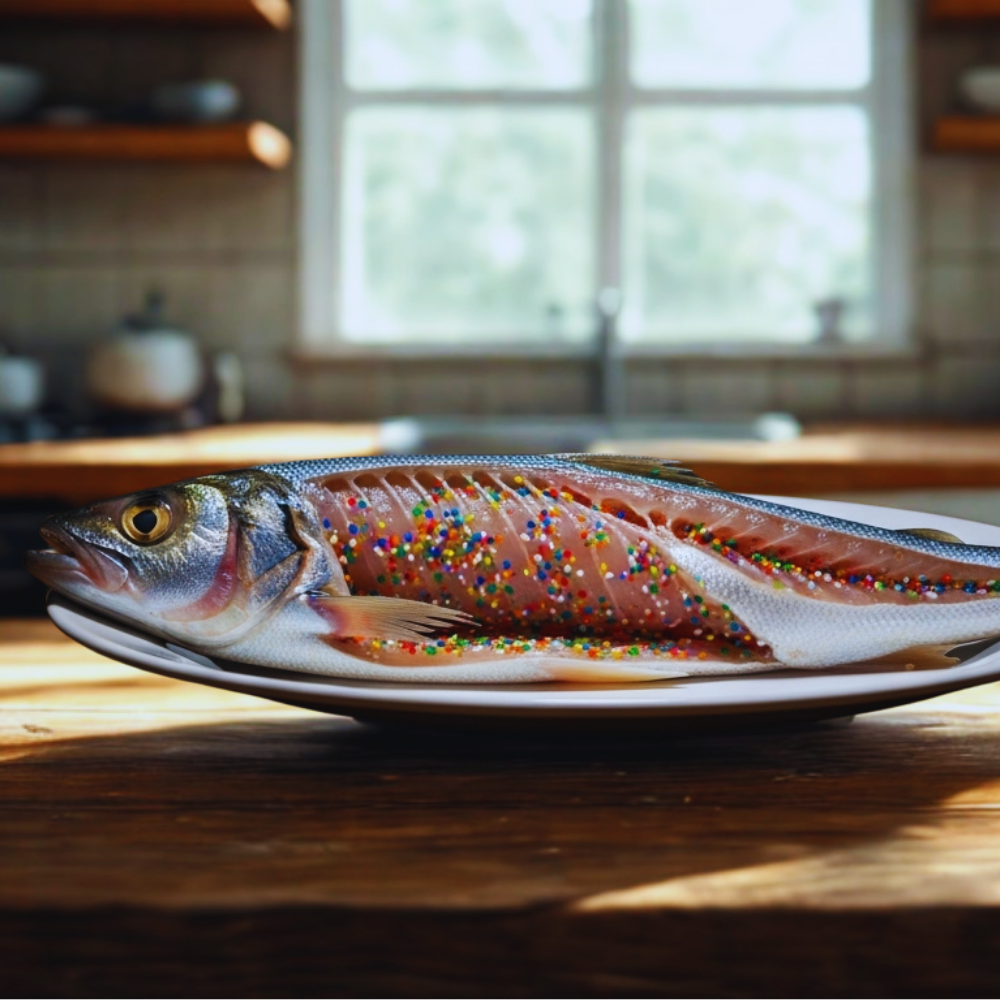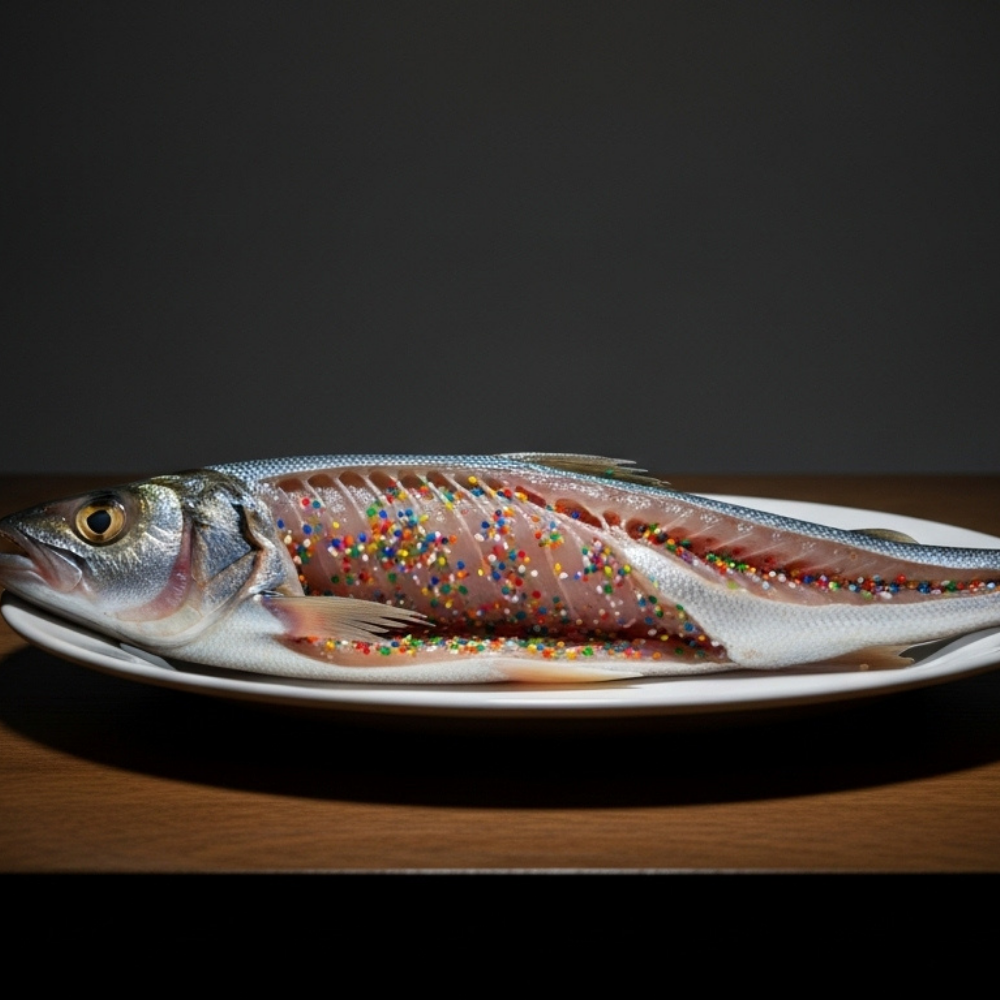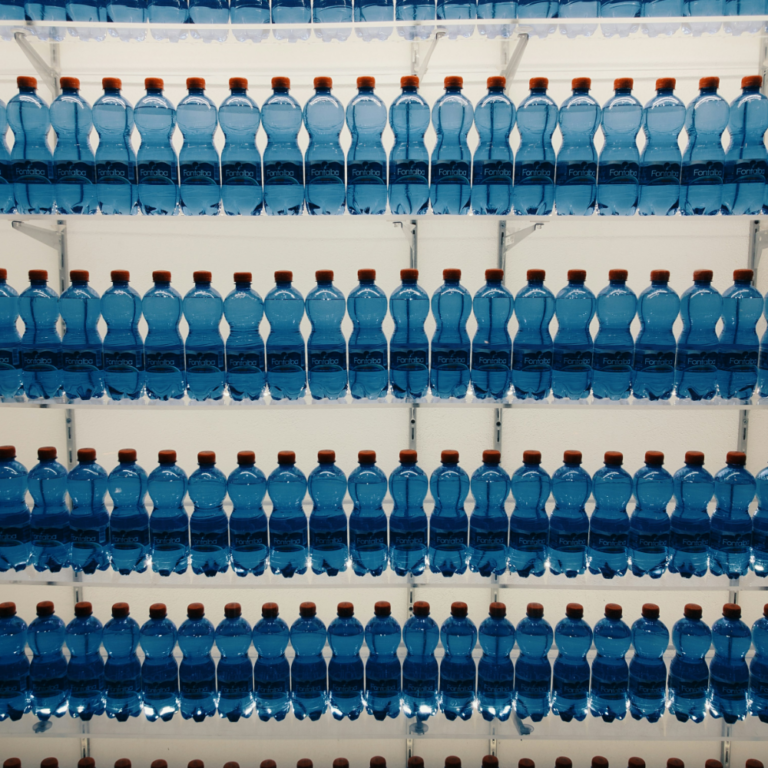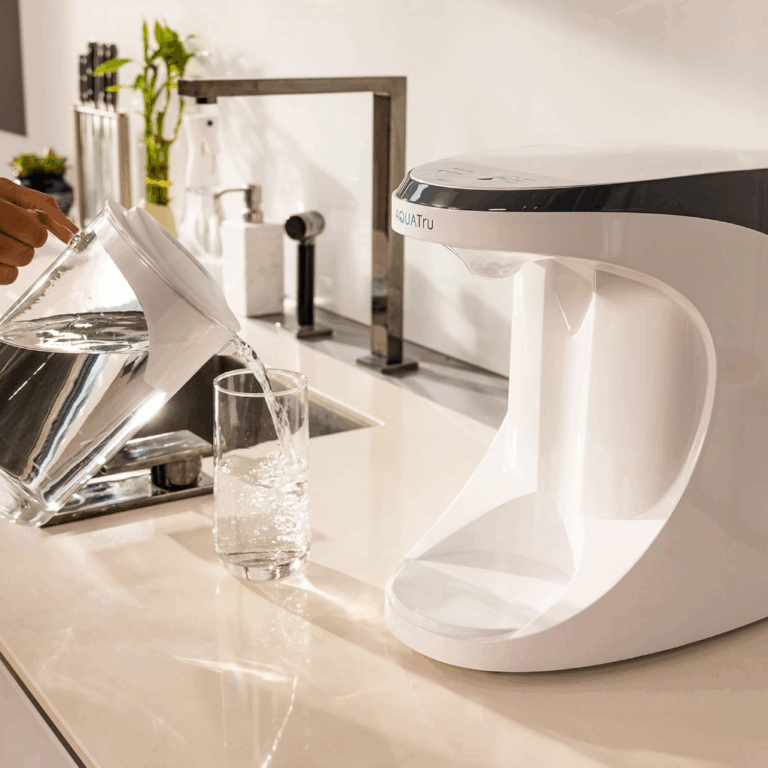
Key Takeaways
- Eating fish is one of the main ways microplastics can enter the human body.
- Contaminated seafood may expose people to tiny plastic fragments and their chemical additives.
- Shellfish like mussels and oysters carry the highest risk since we consume them whole, including their digestive tracts.
Fish has long been celebrated as one of the healthiest proteins on our plates — rich in omega-3s, lean, and a staple of heart-friendly diets. But today, every bite may carry something far less nourishing: microplastics. A 2025 study led by Portland State University found contamination in 99% of common seafood samples, showing just how deeply plastics have entered our food chain.
Scientists are uncovering how plastics move through the food chain, raising urgent questions about seafood safety and our own health. This article unpacks what the latest research shows about microplastics in fish, what it means for human exposure, and how to make safer, more sustainable choices at the dinner table.
How Do Microplastics End Up in Fish?
Microplastics don’t just appear in fish — they arrive there through a chain of pollution that starts with us. Every time plastic breaks down, whether from a tossed water bottle or microfibers shed during laundry, tiny fragments escape into rivers, lakes, and oceans. Once in the water, they quickly become part of the aquatic food system.
Fish encounter microplastics in several ways:
- Direct ingestion: Floating fragments resemble fish eggs or plankton, so species near the surface often mistake them for food.
- Trophic transfer: Even fish that don’t eat plastic directly can ingest it by eating prey that already has.
- Sediment and filter feeding: Bottom-dwellers like flounder encounter plastics in contaminated sediments, while mussels and oysters filter particles straight from the water.
Researchers note that human activity is the root cause. Wastewater plants can’t catch every microfiber from synthetic clothing, and lost fishing gear, packaging waste, tire dust, and even old cosmetic all contribute to the problem.
Once these plastics enter waterways, fish have little chance of avoiding them. As long as plastic production and disposal continue at today’s pace, microplastic pollution in seafood will only grow worse.
Prevalence of Microplastics in Fish and Seafood

Not all seafood carries the same level of contamination. Shellfish usually contain the highest concentrations, while fish fillets tend to have fewer particles. Here’s how different types compare:
| Seafood Type | Microplastic Risk | Why Risk Is Higher |
|---|---|---|
| Shellfish (mussels, oysters, clams) | High | We eat the entire animal, including digestive tracts where microplastics accumulate. |
| Crustaceans (shrimp, crab, lobster) | Moderate–High | Microplastics often found in guts; some species eaten whole (e.g., small shrimp). |
| Finfish (salmon, cod, tuna) | Moderate | Plastics found in stomachs and organs, but fillets (what most people eat) tend to have fewer particles. |
| Cephalopods (squid, octopus, cuttlefish) | Moderate | Can ingest microplastics through prey and water; often eaten whole or in large portions, raising exposure risk. |
📌 Shellfish pose the greatest dietary risk because we consume them whole, while finfish fillets usually contain fewer microplastics.
Not all seafood carries the same level of contamination. Shellfish usually contain the highest concentrations, while fish fillets tend to have fewer particles. Here’s how different types compare:
Microplastics have made their way into seafood at an unsettling scale. Research shows contamination across a wide range of marine species — from shrimp and herring to deep-dwelling fish like lingcod. And we’re not just talking about trace amounts.
A 2024 study in Frontiers in Toxicology analyzed 182 seafood samples from the U.S. West Coast, including black rockfish, lingcod, Chinook salmon, Pacific herring, Pacific lamprey, and pink shrimp. Astonishingly, 180 of the 182 samples contained microplastics or microfibers.
These findings confirm that contamination is widespread in both wild-caught and retail-purchased seafood. Even after cleaning and preparing seafood, microplastics can remain in the parts we eat.
The extent of contamination varies by species, habitat, feeding behavior, and size. Plankton-feeding fish are especially vulnerable since they often mistake plastic fragments for food. Scientists sometimes measure microplastics per gram of tissue to assess how concentrated exposure can become.
The broader truth is clear: seafood has become one of the most consistent pathways of human exposure to microplastics. Whether wild-caught or farmed, very few marine species are escaping this problem entirely.
Don’t Miss: Microplastics in Food: Sources, Health Risks & How to Avoid Microplastics don’t stop at fish — see how they sneak into other foods and what you can do to reduce exposure. Read more →What Happens When We Eat Contaminated Fish?
So if fish eat plastic… what happens when we eat the fish?
Researchers worldwide are racing to answer that question. While the full impact on human health is still being studied, early evidence is troubling, especially with repeated exposure over time.
When we eat seafood that contains microplastics, we’re not just swallowing plastic fragments. We may also ingest:
- Chemical additives used in plastic production include bisphenols and phthalates.
- Toxins, plastics absorb from the environment, including pesticides, heavy metals, and industrial chemicals like PCBs.
Some studies suggest microplastics pass through the gut without being absorbed. But nanoplastics, even smaller particles, have been detected in human tissues such as the liver, spleen, and bloodstream. According to a 2025 report from Stanford Medicine, scientists have now found plastics in places like blood and placenta, though the long-term health effects remain under investigation.
Risk also depends on the type of seafood. Whole organisms like mussels and oysters carry higher levels because we eat them entire, while filleted fish usually contain fewer microplastics unless particles have migrated into the flesh.
Lab studies have linked plastic exposure to several potential health concerns:
- Endocrine disruption (hormone imbalance).
- Oxidative stress and inflammation.
- Altered gut microbiota.
- Possible links to cancer and reproductive issues (seen in animal studies).
In short, eating contaminated fish may not cause immediate harm, but it contributes to our cumulative body burden of plastics and their chemicals. That’s especially concerning for communities that rely on seafood as a dietary staple.
What We Still Don’t Know
The evidence on microplastics in fish is growing, but significant gaps remain. There’s still no standard method for testing, which makes results hard to compare across studies. Nanoplastics are even more concerning, they’re so small they may cross biological barriers, yet they’re difficult to detect and often go unmeasured.
Scientists are also cautious about the long-term effects of chronic, low-level exposure. A single meal may not cause harm, but decades of regular seafood consumption could add up in ways we don’t yet fully understand.
While the science continues to evolve, researchers emphasize that the uncertainty is no reason to wait. Reducing plastic pollution now is the safest path forward.
Can We Still Eat Fish Safely?
The short answer: yes, but with awareness.
Fish and seafood can still be part of a healthy diet, but knowing how microplastics affect them can help you make more informed choices. Not all seafood carries the same level of risk, and how it’s prepared matters, too.
Whole fish and shellfish—like mussels, clams, sardines, or anchovies—are more likely to contain microplastics in the parts we eat. That’s because the digestive tract (where most plastic particles are found) is often consumed along with the meat.
Filleted fish usually have the stomach and intestines removed before they’re sold, which reduces the chances of microplastic exposure. But it’s not guaranteed, especially with long-lived or top predator species like tuna or halibut, where plastic particles may build up in the muscle tissue over time.
If you’re trying to minimize your exposure, here are a few things to consider:
- Choose smaller, short-lived fish that accumulate fewer toxins and plastics.
- Vary your protein sources, especially if you eat seafood frequently.
- Pay attention to how your seafood is sourced. Some aquaculture operations are taking steps to reduce plastic exposure, while others rely heavily on plastic-based equipment.
Ultimately, the issue isn’t whether seafood is “safe” or “unsafe.” It’s about understanding the bigger picture: the more plastic we put into the environment, the more it finds its way back into the food chain. Being selective with what we eat helps, but reducing plastic pollution at the source protects long-term food safety.
What You Can Do
You can’t remove microplastics from the ocean yourself, but your choices still matter. While scientists and policymakers work on big-picture solutions, there are steps we can take to lower our exposure and reduce the demand for plastic in the first place.
🐟 Make Informed Seafood Choices
Opt for filleted fish rather than whole shellfish when possible, since shellfish contain more microplastics in their edible parts. Choosing smaller, short-lived species like sardines or anchovies often means fewer accumulated pollutants compared to large predators such as tuna or swordfish. Adding more plant proteins, such as beans, lentils, or tofu, not only lowers your exposure but also reduces demand on overfished species.
♻️ Reduce Plastic in Your Life
Every piece of plastic avoided is one less that can break down into the environment. Swap single-use packaging for reusable containers, carry your own water bottle or coffee cup, and opt for natural fibers over synthetic materials like polyester or nylon. Even small switches like choosing bar soap over bottled body wash can cut down on hidden plastic. Over time, these swaps add up.
🤝 Support Systems That Make Better Choices Easier
The biggest changes happen when systems shift. Look for grocery stores that offer refill stations, shop from companies working to phase out plastic packaging, and support policies that hold manufacturers responsible for plastic waste. Collective action, such as supporting extended producer responsibility (EPR) laws, helps shift the burden away from consumers and onto polluters.
👕 Wash Your Clothes More Mindfully
Synthetic fabrics shed microfibers every time they’re washed. To reduce this, run full loads on cold, add a microfiber-catching laundry bag or install a filter, and line-dry when possible. Even small changes in laundry habits can keep thousands of fibers out of waterways each year. Buying fewer, higher-quality garments made from natural fibers also cuts pollution at the source.
📢 Stay Informed and Speak Up
Policy change accelerates when more people understand the risks. Stay updated on new microplastics research, share what you learn with friends and family, and engage with local leaders who influence environmental policies. Supporting clean-up efforts or joining campaigns for plastic reduction amplifies your impact beyond personal choices.
Don’t Miss: How to Remove Microplastics from Your Home and Transform Your Environment Everyday choices at home make a big difference. Learn practical steps to reduce microplastics — from cleaning habits to safer materials. Read more →FAQs About Microplastics in Fish
Not every fish has been studied, but research shows microplastics are widespread. A 2024 study on U.S. West Coast seafood found 180 of 182 samples contained microplastics. That means it’s very likely that most fish, especially those near coasts or in heavily fished waters, contain some level of contamination.
Removing the stomach and intestines during cleaning can reduce microplastic content in filleted fish. However, plastics that migrate into tissue or muscle aren’t removed by cooking. Choosing the type of seafood you eat is a more effective way to limit exposure.
Not necessarily. Farmed fish aren’t swimming in open oceans where plastic pollution is heaviest, but that doesn’t mean they’re free from contamination. They can still ingest microplastics through:
Commercial feed made with fishmeal or other ingredients that already contain plastic particles.
Tank or pond water may contain fibers and fragments from surrounding runoff or farm equipment.
Plastic infrastructure, such as nets, ropes, and liners, degrades over time.
Studies have detected microplastics in both farmed and wild seafood, though the sources may differ. The key takeaway is that aquaculture doesn’t guarantee lower exposure — and choosing smaller, short-lived species (whether farmed or wild) is still one of the most effective ways to reduce risk.
While you can’t fully “detox” microplastics once they’re ingested, you can support your body’s natural elimination pathways. Eating fiber-rich foods (like fruits, vegetables, and whole grains) helps move particles through the digestive tract. Antioxidant-rich foods such as berries, leafy greens, and green tea may reduce oxidative stress triggered by plastic-associated chemicals. Staying well hydrated and engaging in activities that promote sweating, like exercise or sauna use, also support your body’s detox processes.
Some people turn to supplements like chlorella, spirulina, or activated charcoal, which may help bind certain toxins, but the research on microplastics is still limited. Always consult a healthcare provider before adding supplements to your routine.
Final Thoughts About Microplastics in Fish
Microplastics in fish aren’t just an environmental issue, they’re a food issue, a health issue, and a systems issue. The research is still unfolding, but the message is already clear: plastic is showing up where it doesn’t belong, including in the seafood many of us eat.
While we can’t eliminate microplastics overnight, we can make choices that reduce exposure and push for change. Choosing seafood more carefully, cutting back on single-use plastic, and supporting policies that reduce plastic emissions all move us in the right direction.
Even small shifts, such as choosing a plastic-free dish soap or using a microfiber filter in your laundry, can make a significant difference when we’re all working in the same direction. It’s not about perfection. It’s about pressure, and enough of it in the right places can lead to real change.
The more we understand how microplastics affect our health and the environment, the stronger the case becomes for rethinking how we use plastic and how it shapes our future.
📚References
- Kacapyr, S. (2024, May 22). Study maps human uptake of microplastics across 109 countries. Cornell Chronicle. https://news.cornell.edu/stories/2024/05/study-maps-human-uptake-microplastics-across-109-countries
- Perkins, T. (2025, February 3). Study finds microplastic contamination in 99% of seafood samples. The Guardian. https://www.theguardian.com/us-news/2025/feb/03/seafood-microplastic-contamination-study
- Portland State University. (2024, April 25). Microplastics widespread in seafood Oregonians eat, PSU study finds. Portland State University News. https://www.pdx.edu/news/microplastics-widespread-seafood-oregonians-eat-psu-study-finds
- Stanford Medicine. (2025, January). Microplastics and our health: What the science says. Stanford Insights. https://med.stanford.edu/news/insights/2025/01/microplastics-in-body-polluted-tiny-plastic-fragments.html
- Times of India. (2025, June 5). Study reveals widespread microplastic presence in seafood along Vizag coast. The Times of India. https://timesofindia.indiatimes.com/city/vijayawada/study-reveals-widespread-microplastic-presence-in-seafood-along-vizag-coast/articleshow/121629222.cms
- Traylor, S. D., Granek, E. F., Duncan, M., & Brander, S. M. (2024). From the ocean to our kitchen table: Anthropogenic particles in the edible tissue of U.S. West Coast seafood species. Frontiers in Toxicology, 6, 1469995. https://doi.org/10.3389/ftox.2024.1469995
- United Nations Environment Programme. (2025, June 2). Everything you should know about microplastics. UNEP. https://www.unep.org/news-and-stories/story/everything-you-should-know-about-microplastics





